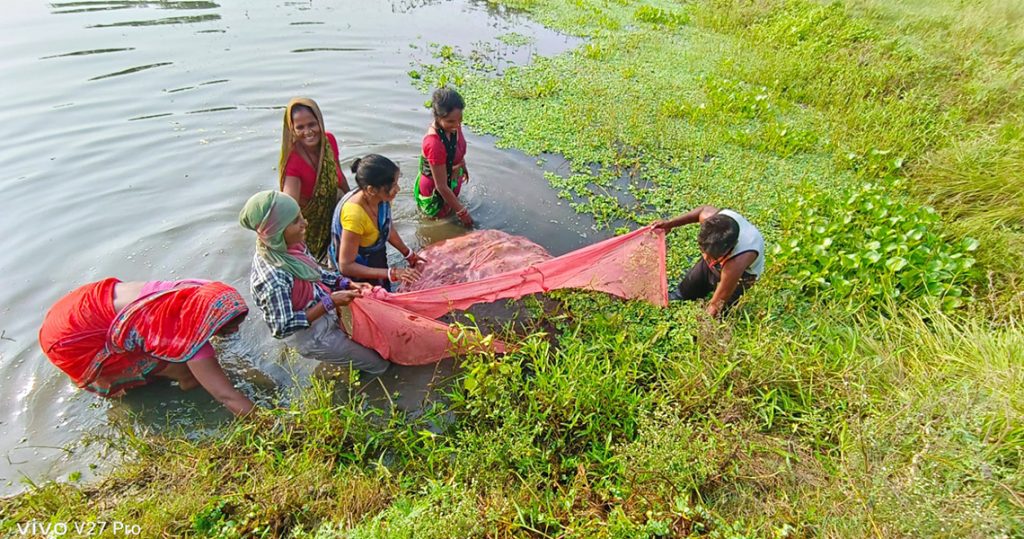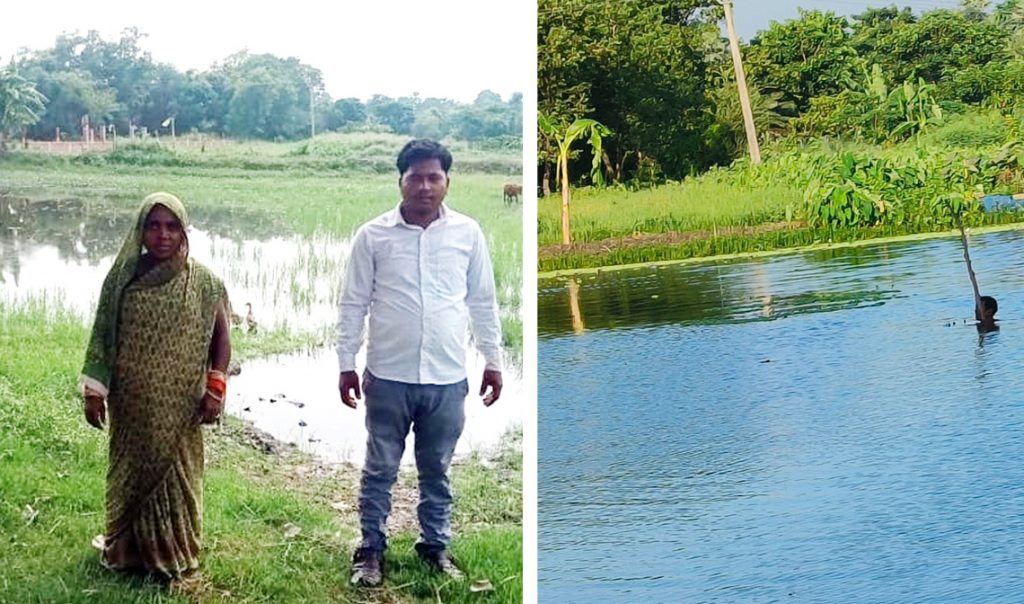Fishing for change: How a policy initiative in India’s Bihar state shows pathways to women’s economic empowerment and climate change adaptation
by Poulomi Ghosh, Sonal Jaitly and Shantanu Sahay
Oct 25, 2023
5 min
Explore the transformative approach that the Government of Bihar has undertaken to boost aquaculture in Bihar, through JEEViKA. This blog delves into how JEEViKA mobilizes women SHG-based fish farmer producer groups (FFPGs) and provides them with access to community ponds and water resources to take up aquaculture as a livelihood activity. This initiative has multiple gains, such as improved income and nutrition, increased access and control of women over community resources, and rejuvenation of water resources to tackle climate change. This initiative brings women to the forefront of a livelihood stream that has traditionally been a male domain.
A sunrise sector
India is the world’s third-largest fish-producing country. It has around an 8% share in global fish production and ranks second in aquaculture production worldwide. The fisheries value chain provides food security and livelihood support to more than 28 million people nationwide.
The Department of Fisheries and the Ministry for Fisheries, Animal Husbandry and Dairying consider India’s fisheries sector a “sunrise sector.” Sunrise industries have high growth rates, many startups, and high levels of venture capital funding. The sector has witnessed an average double-digit annual growth rate of 10.87% since 2014-15.
Inland fish cultivation in the country increased from 6,136,000 tons at the end of 2013-14 to 12,121,000 tons by 2021-22. Inland fish cultivation comprises commercial fishing operations that take place in freshwater. This can include capture fishing, which involves catching naturally occurring fish in water bodies, and fish farming, which is deliberate cultivation from seeds.
India’s Prime Minister called for a “blue revolution” in December 2014. The PM Office took several measures to harness fisheries’ potential, which included the inauguration of a separate Department of Fisheries under a new Ministry of Fisheries, Animal Husbandry and Dairying. The Government of India also launched its flagship pisciculture program, Pradhan Mantri Matsya Sampada Yojana (PMMSY). This program marked the highest-ever investment of INR 200.5 billion (~USD 2.41 billion) in the fisheries sector to boost responsible and sustainable fish production nationwide.
Domestic production and Bihar’s place on the fishing map of India
States like Andhra Pradesh, West Bengal, and Gujarat lead India’s fish production. The eastern Indian state of Bihar is not a significant contributor to India’s fish production. Bihar’s annual aquaculture production was around 762,000 tons in 2021-22, whereas the state’s estimated demand for fish was 850,000 tons. Supply from Andhra Pradesh, West Bengal, and Nepal fulfills Bihar’s demand for fish.
Yet, the state’s fish consumption is 9.6 kg per capita, which is lower than the India Council of Medical Research (ICMR)’s 11.2kg per year recommendation. With population growth, the state’s demand for fish is expected to reach 1,137,000 metric tons by 2050. Bihar’s abundant natural freshwater resource and flourishing inland fish market make it ripe for aquaculture. This sector has untapped potential that can lead to equitable economic opportunities in the state.
Bihar’s women-led community pond aquaculture drives change
Fishing has traditionally been a male domain, despite women’s involvement in pre- and post-production activities, such as rearing, feeding, cleaning and processing, and fish marketing. Out of ~5.4 million Indians engaged in full-time fisheries, 1.5 million are fisherwomen. The Post-harvest activities workforce comprises more than 66% of female workers.
Due to adverse social norms, women’s paid and unpaid roles in the fisheries value chain remain invisible and unrecognized. For instance, social or cultural pressures often restrict their opportunities and access to markets near their homes. Additionally, the responsibilities associated with their family’s daily needs can reduce their available working capital. Female fisherfolk also lack ownership and control over resources, such as ponds, tanks, waterbodies, technology, finance, transport, and other inputs for aquaculture.
The Government of Bihar seeks to change this scenario by organizing women from low-income households into self-help groups (SHG) -based fish farmer producer groups (FFPGs). It has channeled this endeavor through JEEViKA, the State Rural Livelihood Mission of Bihar.
JEEViKA seeks to drive social and economic empowerment for rural poor people. It focuses on the socioeconomic development of rural households through a three-tier structure of community-based organizations of women. The three-tier design involves self-help groups (SHGs), cluster-level federations, and village organizations (VOs), which in turn are a federation of SHGs in a village or group of villages.
The government gives these groups free of cost access to village ponds or tanks for five years to operate fisheries as a livelihood-supporting activity. The government identifies and allocates community ponds to VOs. The VOs then develop and maintain the pond through FFPGs formed with SHG members in JEEViKA’s network. This encourages women-led community pond aquaculture.
Most such ponds require a lot of physical labor and maintenance from the FFPG members. The members must clean, fence, keep animals and birds away, and do daily pond maintenance to make them production-ready. After their preparation, these ponds become valuable assets for SHG members. This approach reflects a gender-transformative policy that gives women greater control over a productive community asset to empower them.
JEEViKA supports these women with business plan development, initial capital support, and technical fisheries knowledge to get them started with fish production. JEEViKA helps them to conduct this as a group-owned and run business where all group members take equal responsibility and share profits.
As of October 2023, the Bihar government had allotted 121 ponds to VOs across 29 districts and formed 91 FFPGs. 22 of the advanced and trained FFPGs have harvested more than 21 metric tons of fish and collectively earned INR 3.59 million (~43,000 USD) over the past year. This is no small feat. It speaks of women-led aquaculture’s potential as a strong livelihood stream.

Revival and transformation of community water assets
Community ponds are critical water assets for local livelihoods, rainwater harvesting, and groundwater recharge to avert water crises and tackle climate change. Down To Earth, an Indian NGO, reports the existence of 250,000 ponds in Bihar in the early 1990s. The number has now declined to less than 100,000. Multiple factors, such as rampant illegal encroachment, pollution, and human neglect, have caused their disappearance.
MSC’s fieldwork shows that the allocation of these ponds to JEEViKA’s women FFPGs has led to their rejuvenation and maintenance. Women in these groups have teamed up to clean ponds as large as 3.8 acres and more in some districts. In doing so, they have overcome their internalized beliefs about what women can achieve. They have tackled backlash from local influential encroachers, divided tough physical labor for pond maintenance on a rotation basis between group members, and learned technical aspects of pond health maintenance from JEEViKA-appointed Matsya Sakhi. Matsya Sakhis disseminate technical knowledge of fishing and provide guidance. For instance, they help farmers maintain pond and water quality, understand the optimum harvesting and stocking cycle, and choose the correct fish feed, among other aspects.

The way ahead
The Government of Bihar’s work on fisheries has demonstrated that applying a gender lens to policies can drive equitable growth. The transfer of ponds’ ownership to women-led FFPGs along with technical and capacity-building support from JEEViKA, shows the promise of multiple gains: improved incomes, nutrition, and rejuvenation of neglected water assets critical for tackling climate change. Last but not least, there is confidence and a spring in the steps of the strong fisherwomen in the making.
 by
by  Oct 25, 2023
Oct 25, 2023 5 min
5 min


Leave comments